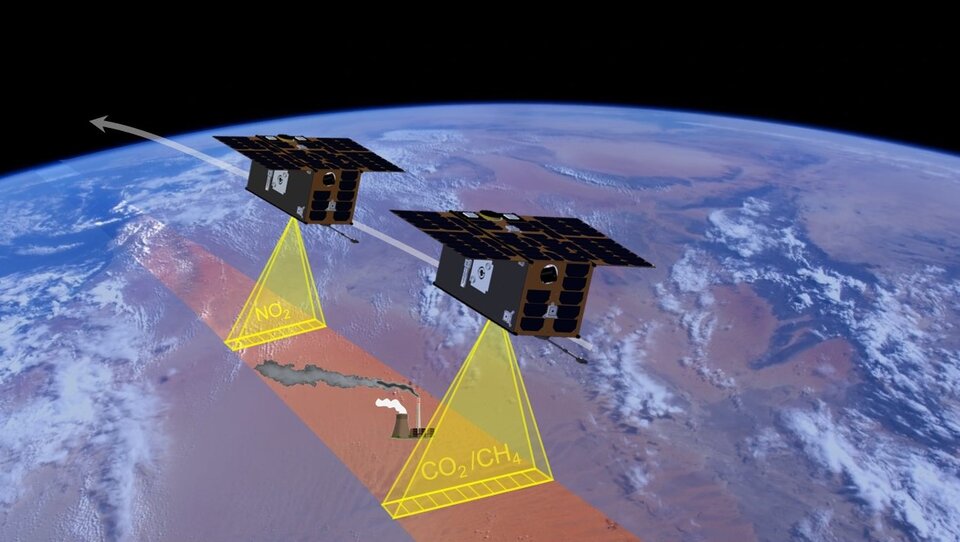Scouts: ESA’s agile research missions
Complementing the well-established series of Earth Explorer research satellite missions, Scout missions are a new component of ESA's Earth Observation FutureEO programme. This new family of small satellites delivers value-added science, either by miniaturising existing space technologies or by demonstrating new observing techniques. Importantly, the overarching aim is to achieve all of this quickly.
Science and technology in the field of observing Earth from space is evolving at an increasingly rapid pace. Keeping ahead of the game and embracing the concept of New Space, the new Scout category of satellite missions follows an extremely agile and low-cost development process while offering the space industry and academia a proactive role.
A Scout mission is defined by three key aspects:
- It must deliver innovative science and technology
- It must cost less than €30 million (€35 million pending approval)
- It must be developed within three years, from kick-off to launch
Scout missions are literally scouts; they pave the way to innovative science in a quick and agile fashion.
There are currently three Scout missions in the process of being developed: HydroGNSS, NanoMagSat and Tango.
HydroGNSS

HydroGNSS will improve our knowledge of Earth’s hydrological cycle, and in turn, improve our understanding of natural processes and the way human activity affects land and water.
The mission will sense signals reflected by Earth’s surface from the Galileo and GPS navigation missions – a technique called GNSS reflectometry. This will allow for the observation of essential climate variables such as soil moisture, inundation and wetlands, freeze–thaw over soil and permafrost, and above-ground biomass.
HydroGNSS comprises two small satellites, each measuring 50x50x70 cm and each weighing about 60 kg. They will orbit Earth at an altitude of 550 km. Launch is planned for 2024 and the mission will provide observations for 4.5 years.
NanoMagSat

Following on from the current Swarm Earth Explorer mission, which was launched back in 2013, NanoMagSat aims to maintain Europe’s leadership in monitoring Earth’s magnetic field. In addition, NanoMagSat will measure the ionospheric environment. NanoMagSat will allow for a much-improved understanding of the dynamics of the magnetic field and of the role of the Sun in the coupled atmospheric–ionospheric–magnetospheric system.
Information delivered by NanoMagSat will be used in many ways, such as for space weather hazard assessments, precise navigation, reference models for smart phones, directional drilling and in the World Magnetic Model.
The mission will comprise a constellation of three 16U satellites, launched nine months apart.
Each 24-kg satellite will carry a miniaturised absolute magnetometer at the end of a boom and a high-frequency magnetometer half-way along the boom for magnetic measurements, a Langmuir probe to measure electron temperature and density, and two GNSS receivers.
Tango

The Tango mission will measure and monitor three greenhouse gases: methane, carbon dioxide and nitrogen dioxide being emitted from large industrial sites.
This new Tango Scout mission will complement measurements of methane and nitrogen dioxide from the current Copernicus Sentinel-5P mission and the upcoming Copernicus Carbon Dioxide Monitoring mission which will measure carbon dioxide and methane from human activity to help verify the Paris Agreement.
Tango will monitor 150–300 known large industrial facilities and power plants every four days. It will deliver high-resolution images of emission plumes as well as the surrounding pollution, with sufficient accuracy to determine emissions with a single observation. In fact, Tango will deliver higher-resolution images at these specific locations compared to the other three missions noted above provide, so therefore acts as a magnifying glass.
The Tango mission will comprise two 25-kg satellites orbiting in tandem: one configured to measure methane and carbon dioxide and one to measure nitrogen dioxide.
NOTE
In 2022, CubeMAP, which set out to improve out knowledge of upper-atmosphere processes, was selected as the first Scout mission. However, in June 2023, ESA's Earth Observation Programme Board took the decision to terminate its development. This was because the development path was exceeding programmatic constraints with respect to timeline and budgetary boundaries allocated for this category of mission. Read full article: CubeMAP mission development halted







